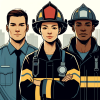You may recall a story of how several Illinois state legislators had petitioned Gov. Pat Quinn to recognize by executive order the fire training certification of returning military veterans as an equivalency to the Illinois Firefighter I and II standard.
Illinois is one of only 12 states that have yet to recognize the U.S. military’s fire certification as a basis to meet its basic state standards. This legislative proposal has the support of the Association of Fire Fighters of Illinois.
The story itself is interesting, and as yet Gov. Quinn has not given any indication if he will issue the executive order. His spokesperson indicated that a state task force has been meeting for nearly a year to decide if returning veterans meet state licensure requirements.
In the meantime, career and volunteer fire departments that want to utilize these returning veterans, have the expense of what appears to many as redundant fire training.
Perhaps both some historic and current background will lead to a better understanding of the issues surrounding these certifications.
In the beginning
Today’s fire service can trace its rich heritage back to colonial times when many of those leaders who would later shape the founding of the United States first turned their energy toward another common enemy — fire.
For example, Benjamin Franklin was the first chief of the Union Fire Company of Philadelphia that was the first organized volunteer fire company in the American colonies. Hence, we also recognizes Franklin as the first fire chief in America.
George Washington, prior to the Declaration of Independence and his selection as general of the Continental Army and subsequently his election as the first president of the United States, was a founding member of the Friendship Company of Alexandria, Va. that formed in 1775. Washington purchased the company’s first engine from the Gibbs Co. of Philadelphia, and the station was built in a central location to cover both Alexandria and his estate at Mt. Vernon.
Civil War era
In the early days of the Civil War, some 1,100 volunteer firefighters from New York City formed the Eleventh New York Infantry Regiment under Colonel Elmer Ellsworth. Informally, the regiment was referred to as the First Regiment of Fire Zouaves and was known for their colorful uniforms consisting of a red firefighter’s shirt, gray jacket and gray flowing trousers bloused into their boots.
While stationed outside Washington in May 1861, the regiment helped extinguish a major fire in the city’s Willard Hotel, which brought them quickly to attention of President Lincoln.
Later that year, over 200 of the Zouaves were killed, wounded or captured during the first battle of Bull Run.
During that war, many other firefighter regiments were formed in both the North and the South and a popular motto of the times was, “In peace, firemen; in war, soldiers!”
Modern times
The fire service has long recognized that returning military veterans with their understanding of discipline, teamwork and esprit de corps held the same fundamental values shared by firefighters. Those men and women with military firefighter certifications returning from duty during the operations in Iraq and Afghanistan are no exception.
Recently, the Department of Defense consolidated all military fire training at Goodfellow Air Force Base outside San Angelo, Texas. Every firefighter designee in the Army, Navy, Air Force and Coast Guard passes through Goodfellow for their basic Firefighter I and II, crash fire rescue, rescue tech, hazmat and even fire inspector training.
These DoD training courses meet the IFSAC testing criteria that assures the courses meet or exceed the NFPA professional standard for that specific certification.
Recognition of this training by the 38 states is beneficial to both the states and the military. Shortly after 9/11, when I was fire marshal for Ohio, Ohio’s adjutant general was faced with the costly expense of sending CFR-trained members of the Ohio Air National Guard out of state for new or refresher certification.
Since the Ohio Fire Academy, one of the nine Bureaus of the Fire Marshal’s Office, was already IFSAC accredited, the Academy added CFR courses to its training schedule, thus keeping Guard personnel in state in the event of a deployment and with a cost savings that could be used for other homeland security expenses.
The red tape
In most states, veterans with military firefighter certifications need to make an application to the state’s fire training academy or fire training certification board requesting that their training be considered for equivalency to the state’s firefighting requirements.
Normally, this requires copies of the military certifications and an affidavit regarding the number of hours for each course attended during the DoD’s training at Goodfellow AFB. Some states may request a skills evaluation by a state-certified instructor, especially when the training also includes some level of EMS certification.
With this equivalency, returning veterans with current military firefighter certification could almost immediately begin to protect their communities without the added expense to the department of redundant fire training.
Some departments augment military certification with bridge classes of their own that may last several weeks to orient probationary firefighter into the standard operating procedures of that department and to access the specific skills of each new firefighter.
Several larger departments, despite the added expense, prefer to place the military veterans into a standard fire recruit class. Their reasoning is to build an esprit de corps within the class and use the ex-military firefighters as positive role models for their fellow probationary firefighters.
Whatever happens with the request in Illinois, I hope the fire service will continue to universally embrace our returning veterans. History, from revolutionary times through the World Wars and most recently from Vietnam, Iraq and Afghanistan, has shown that veterans generally make outstanding firefighters.













